Abstract
Sustainability practices in a working environment represent superior quality performances, while risks remain to be a challenge. Our study’s primary purpose is to deploy the bibliometric method to analyze the related literature. Bibliometric parameters analyzed using the VOSviewer software were employed to identify citations relevant to sustainability and risk contexts’ critical themes. From 1990–2020, a reflection of 1233 documents appeared in Scopus on sustainability practices and risk management. We searched the current papers, authors, institutes, and keywords on VOSviewer. The bibliometric search provided us an understanding, which reflected that the collected works on literature of sustainability and risk factors, in general, is suggestively increasing. Mainly, in our report, we highlighted six major streams, related to topics such as the moral responsibilities and sustainability development, blockchain technology and minimization of risks, social sustainability and supply chain, environmental impacts, safety engineering and risk identification, and optimization and sustainability practices. The primary purpose of using streams was to cite the key authors and their contributions to the related literature. This bibliometric analysis was developed to obtain further understanding regarding the importance of sustainability to the individual, firms, and the entire economy. Moreover, the factors associated with risk also sought to be examined to prevent or at least minimize its negative impact. It was identified in this paper that sustainability remains an issue in the global perspective that has been challenging the individual and/or the organization’s point of views. Risk factors were also identified as inevitable; hence, everyone must be socially responsible to minimize the negative impact on the economy.
1. Introduction
Sustainability consists of a wide scale of models connected to integrating economic, social, and ecological concerns [1]. The practices of sustainability deal with responsible actions by taking being resourceful into consideration. Sustainability of economy ensures we make efficient use of resources that could prove to be long term secure structures [2]. Social sustainability consists of social reliability, social investment, public progress, and social accountability. When societies are neutral, diverse, connected, and independent, they are responsible for better life superiority. Finally, environmental sustainability suggests that regular possessions should be preserved at an ecological frequency as these are commonly nonrenewable. It indicates preserving ecological assets, or at least not depleting them [3]. The other name for sustainability is “corporate social responsibility”. CSR is a multidisciplinary concept whereby corporations can reflect on the effective practices of studying the best actions for responsibility, which may mean intelligent and objective concern for the community’s welfare. Earlier, most business organizations’ emphasis was philanthropic; sustainability structures currently served to succeed the moderate initiations surrounded by corporate significances and common social prerequisites [4]. A corporation may have evaluated and assessed its risk, which was unpredictable and unknown. The sources of risks could be pure or dynamic [5].
Pure risks usually are static risks [1]. The primary sources arise from the base of pure forms of risks that bring threats or vulnerabilities, causing physical damage to individual business assets or possessions. Pure risks strike an organization due to uncontrollable natural forces, which might frequently arise in the phases of external sources. They may perhaps arise from floods, rainstorms, underground eruption, twisters, fire, power-driven failures, or technology’s collapse due to natural calamities. In every stage of a business lifecycle, risks are uncertain in the environment [2]. Speculative risks, on the other hand, can strike a business corporation from factors such as competitive factors; fluctuations in stock values; mismanagement of business practices; lack of proper planning; inadequate controls on business establishments; changes in laws or regulations; changes in modern trends; unethical practices such as dishonesty, fraudulence, or theft; or misusing companies’ assets for personal gains [2].
Businesses have been challenged by various factors, especially by the socio-economic context in the present, resulting in these firms identifying new opportunities and developing new strategies to retain and improve their competitive advantage [6]. Firms that adopt innovation successfully gain positive and significant benefits such as profits, growth, and new market opportunities [7].
In general, we understand that risks could arise from internal aspects or external aspects, which could impact the business environment’s sustainability and operational practices. [8] Every business is committed to satisfying specific responsibilities that it owes to the general public. [9] This paper employed a bibliometric analysis of sustainability and risk management to develop and gain a further in-depth understanding of the importance of sustainability to each individual, organization, and the entire economy. Moreover, we also sought to further investigate the factors associated with risks and their impact. The results of this study shall contribute to the existing literature regarding sustainability and risk management.
We were able to generate the top most influential authors, country distribution, citations and sources, citations of documents, organizations, and affiliations of universities using the Scopus database. In addition to that, we have developed six streams for the cluster analysis, such as moral responsibility and sustainability development, blockchain technology minimizing risk, social sustainability and supply chain management, environmental impact, safety engineering, and optimization. Our recommendations for future research and conclusions shall also be included by the end of this paper. The remainder of this paper proceeds as follows: Section 2 presents the materials and methods, the results of the bibliometric analysis are presented in Section 3, the discussion of cluster analysis showed in Section 4, and recommendations for future research presented in Section 5. Finally, the study is concluded in Section 6.
2. Materials and Methods
We began by using an analysis with bibliometric references and citations to collect the greater quantity of literature on sustainability practices and risk dimensions [10] and framework of background analysis for around 1233 document articles for 32 years from 1989 to 2020. A science mapping method has been employed to analyze the existing literature, which involves the analysis of bibliographic data related to a corpus of documents drawn from a field of study [11]. Bibliometric analysis can facilitate the mapping of large volumes of scientific literature [12]. Bibliometric analysis anticipates a similar form of systematic literature reviews and rigorous techniques that guarantee the quality of the information used and results’ output generated [13]. We also used VOSviewer software to construct and visualize linkages of bibliometric sources to source top authors to extract refined information from publications, academics, or individual journals [14].
To accomplish the research aim and get over the quoted parameters, we executed an organized literature review to ensure logical consistency in plotting the understanding, formed roughly so far, of the connection concerning sustainability and dimensions of risks. Our analysis follows the support of the bibliometric process of view of correspondences, through a bibliographic connecter, which leads to the documentation of three refrains of assessment on dimensions of risks and sustainability. We learned about exporting the bibliometric particulars of the documents into an Excel workbook [15].
One of the most significant great drifts in sustainability, continuing from the past few centuries, has been corporate objectives for acquiring support for sustainability, along with risk management protocols. Even though significant risk managing and sustainability experts are motivated to be unconvinced by one another, the up-to-date method promotes clear unimpaired vision over confined rational thinking [16].
There are various reasons why researchers adopt the bibliometric method: First, research studies with data are considered more relevant than the subjective evaluation. Second, subjective and critical scientific paper synopses can be obtained through traditional reviews. Finally, bibliometric methods help in obtaining scientific review overviews [17]. Furthermore, in this study, we opted for VOSviewer for generating, visualizing, and evaluating the networks in bibliometrics. There is other existing computer software that can also help in bibliometric mapping; however, VOSviewer focuses on the bibliometric map’s graphical representation, which enables the audience to easily assess and interpret the bibliometric maps due to its large display function [18]. Bibliometrics has been widely used in various contexts, ranging from the traditional assessment of the citation impact [19] to the identification of the factors impacting the environment [20]. This software has been widely used in various studies to assess different articles and visualize the data networks [21].
We chose the Scopus database for bibliographic research for systemic projected literature analysis on risk and sustainability dimensions, which is accessed through Elsevier. We explored the Scopus database on 5 November, 2020 to obtain the journals and articles related to sustainability and risk management. The bibliographic archive had records of over 2000 multidisciplinary subjects, which we have used to support the bibliometric study centered on the visualization of resemblances method. For searching for more relevant data, we refined data on the topic of sustainability and risk where the file was extracted by exporting the data to a CVS file, exporting the citations information, bibliographical information, abstracts, keywords, findings, and other related info. We used keywords such as “sustainable” and “risk”, with the application of some filters linked to sustainability and the concepts of risks associated with allocating the search practice. We concentrated the pursuit merely in the heading because using a comprehensive exploration saved not openly correlated reports [22]. The exact keyword search is presented below:
TITLE ( “sustainab*” AND “risk” ) AND ( LIMIT-TO ( DOCTYPE , “ar” ) OR LIMIT-TO ( DOCTYPE , “cp” ) OR LIMIT-TO ( DOCTYPE , “ch” ) OR LIMIT-TO ( DOCTYPE , “re” ) OR LIMIT-TO ( DOCTYPE , “no” ) OR LIMIT-TO ( DOCTYPE , “le” ) ) AND ( LIMIT-TO ( LANGUAGE , “English” ) )
Using bibliometric searches, we learned sorting dimensions of analysis and units. For bibliometric analysis, we deployed mixed citations. The citations included co-authorships, which helped in examining the research field’s social structure [23], a bibliographic coupling that utilized several references shared by the two documents as comparison measure [1,24,25], co-occurrences to comprehend the document set patterns that underlie the research [26], and co-citations, which could help to determine the conceptual structure of the topic of the study [27]. To generate and produce the figures and data from cited articles, we conducted co-occurrence analysis of keywords, co-authorship analysis of the influential authors and country distribution, co-citation analysis of cited sources, citation analysis of documents and organizations, and co-citation reference network analysis in sustainability and risk management to generate the clusters/streams.
The network analysis of the top high occurrence keywords is presented in Figure 1. The keywords included sustainable development, threat, risk sensitivity, decision making, environmental impact and risk, and sustainability practices to select the most essential cited journals.
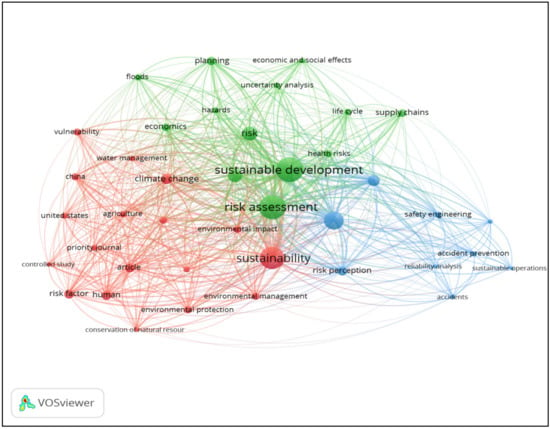
Figure 1.
Network Analysis with keywords (VOSviewer software).
All the articles carrying all or any of these keywords were to be included in this study. However, there was also some exclusion; the publication date of the articles must be between 1989 and 2020 only, making the articles published before 1989 rejected. To build up a more informative assessment on the relative importance of specific terms within the clusters; citation, occurrence, and co-occurrences were analyzed to identify related themes under each cluster [28] Our coverage of deep literature on the subject of Scopus generated about 1233 articles to extract more detailed topics. To get a more elaborative bibliometric analysis idea, we will discuss the accumulated representations in findings and analysis.
Figure 2 below represents the bibliometric process implemented in this study
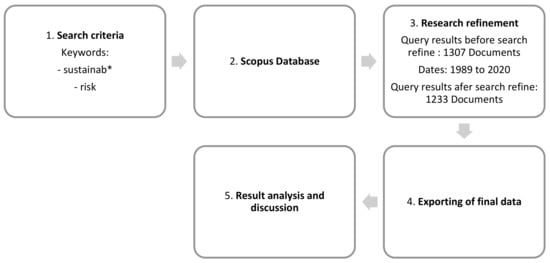
Figure 2.
Bibliometric process of the study.
3. Results
3.1. Published Documents on Sustainability and Risk Assessment
In Figure 3, complete bibliometric research was lead using the VOSviewer software, along with Scopus. Our analysis contained 1233 documents from the year 1989 to 2020.
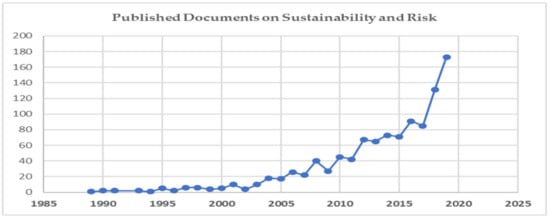
Figure 3.
Top published journal documents on Sustainability and Risk assessment.
3.2. Keywords Analysis
As shown in Figure 1, we used network analysis where the critical leading related words connected to sustainability and risks were identified in the research study. The network analysis, using keywords, accompanied the software of VOSviewer to pinpoint more than quite a few ranges and information on investigation of sustainability and risks generally impacting the firms. It was generated through conducting a co-occurrence analysis of both author and index keywords. The significance of this analysis is that it helped the researcher to reveal the research field’s development and structure. It helped in mapping the scientific literature’s intellectual structure [29]. The keywords could be obtained from the publication’s title and abstract; however, there was a restriction for single words. The figure represents a grid centered on replicating keywords in the literature on general dimensions of sustainability and risks. The linkage in the network analysis showed that environmental impacts, sustainable development, risks, vulnerability, climate change, risk perception, economic and social factors, health risks, accident prevention, and risk assessment are the key related backgrounds in the literature we perceived. As we selected our research connectedly on the generalization of sustainability and risk dimensions, a few keywords, such as China, decision-making, and humans, usually do not result in a literature search of sustainability or risks. Figure 1 shows that risk assessment and sustainability have passed over the essential and most crucial research context on how sustainability and risks can impact firms in general. The slight gaps in the network analysis can be closed with the relevant speculative acquaintance of data in our research study through crucial citations of keywords for research in the future.
3.3. Influential Authors
Using the VOSviewer software, we conducted a co-authorship analysis, which is a tool used to identify the key organizations and scientists, as well as examine their association [1]. It helped us to generate the leading authors and rank them by documents and citations. The documents’ publication characterized the most significant ten authors, as well as another set-top ten authors whose citations were most potent in Figure 4 and Table 1. Based on Table 1, the most potent authors were Dong Y., Frangopol D M., and Li Y. (six documents). Likewise, if we saw the authors represented by citations, we saw 311 by Harman E, followed by Busse C (210 sources) and Bode C. (162 references), we can view similar patterns from the format. Almost 20,113 authors were spotted on VOSviewer, where we focused on the top 10 prevailing authors with documents as well as citations.
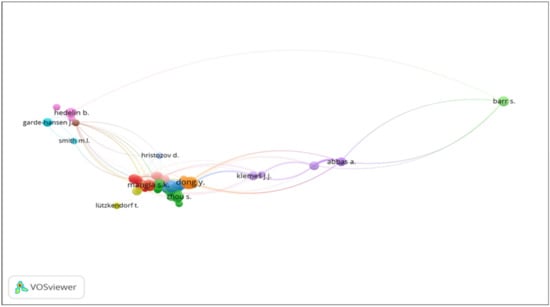
Figure 4.
Influential Authors generated using VOSviewer.

Table 1.
Prominent Authors by documents and citations.
3.4. Country Distribution
In Figure 5, the list of influential top origin of countries was identified in the network using VOSviewer software, where the countries were ranked by number of documents and the ranking of the states was also based on citations from the previous 32 years. Using the co-authorship analysis, the trending collaboration among the influential countries was assessed. Similar to the scientists, we also sought to identify opportunities in discovering new information and knowledge through collaboration [47].
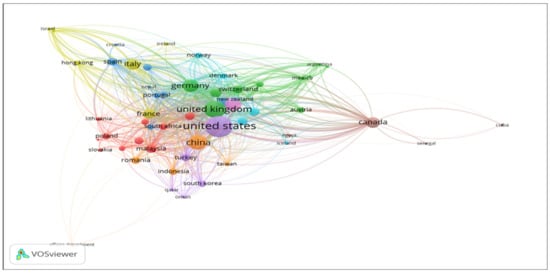
Figure 5.
Analysis of citation network identifying the origin of a country for diverse authors.
The top 10 countries in Table 2 represent the highly graded documents. The top-ranked citations of the countries show that, in the leading position through documentation and citations, United States was the first country to research and initiate more on the work practices of sustainability and to analyze the study of risk impact on firms compared to other countries ranked. The United Kingdom was the second-ranked country by citation and documentation. The nation was working closely to create an overview of its progress with sustainability indicators, evaluation of risks, and mitigating measures. Likewise, the country of China was ranked in the third position, which is considered to be close to emerge with the concept of sustainability practices and reduce the measures of risks in the associated line of diverse firms or organizations. Countries with an emerging economy were scarce and irregular in the literature as these countries did not have enough resources. Most organizations may not adopt sustainability factors as it remains a challenge and requires a more significant amount of capital investment. Hence, countries with an emerging economy should utilize sustainability to improvise society’s triple line approaches, economy, and environment.

Table 2.
Prominent country by documents and citations ranked.
3.5. Citations and Sources
In Figure 6, required journal distribution and linkages were generated in VOSviewer and Scopus software to isolate the handful of journal distributions and links that were done by using the co-citation analysis of cited sources. This type of analysis enabled us to visualize the relationship between the publications [48]. The top nine ranked journals were in two categories: the highest number of documents in a journal reported with the highest number of distributed journals published on the subject matter. Secondly, a highly cited number of journal documents were ranked.
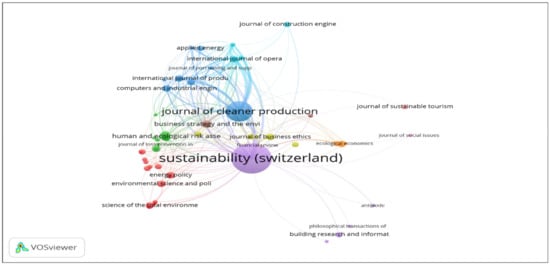
Figure 6.
Citations of journal network using VOSviewer.
In Table 3, sourced by published journals on the topic, Sustainability (Switzerland) journal ranked first with a higher document availability of 99 papers. The source, with citations, of published journals showed some gaps as the highest ranked journal publication was shown to be the Journal of supply chain management with 1069 citations. Philosophical truncations of the royal society with biological sciences cited around 621 documents. Unexpectedly, in the sourced citations, a limited journal in the field of sustainability, with 189 document citation, was ranked as ninth, which implied a not significant number of proper citation references with sustainability practices. On the other hand, risk analysis, had citations of 259 sources, but by documents, there were no documents with the “risk perspective.” As per our analysis, we found that sustainability vision had a shortage with organizations’ low perspective, ignored by organizations and business journals. Moreover, from our sourced citations of networks on journal distributions, the cited articles were more on the top-ranked, with supply chain management ignoring and overlooking less prominent journals, leading to the bias of citations.

Table 3.
Top nine, prominent source by documents and citations ranked for journals.
3.6. Citations of Documents
In the format of Figure 6, the dominant authors issued journals with citations of years acknowledged using the VOSviewer software. The result was drawn from conducting citation analysis of documents. This analysis is considered one of the most important parts of a bibliometric study [49]. Significant authors have researched sustainability and risk aspects; from the database, we found that 20,175 authors have put out articles appropriate to sustainability and risk between 1989 and 2020. To categorize the most applicable and, the top authors ranked, lists were cited documenting 20 cited authors whose citations showed more than 100 published papers.
3.7. Organization
Using the software of VOSviewer and citation analysis, we gathered the top 10 affiliations where we could observe the published documents of sustainability and risk journals under the entity of organizations where the research has accompanied their principal investigations on the focus, the results reported in Table 4. Furthermore, the bibliometric study considered exploring the published journal and references and listing the highest 10 affiliations. In the list, we observed that the School of Industrial Engineering, University of Tehran, and the College of Engineering Tehran published the most journals on sustainability practices and associated risk management with five important journal documents. “Ghent University Belgium” from the Department of Geography published the three most important published journal documents on sustainability practices and risk factor management. We observed most of the subsequent affiliations listed by almost the same figure as the three most important documents.

Table 4.
Top 10 universities in the dataset by number of affiliated documents published.
3.8. Affiliations of Universities
We observed in the affiliations of documents in Figure 7 the conception of correspondence exploration, created on bibliographic coupling; the stemmed articles documented frequently explored private enterprise in addition to the context for sustainability. This was done through conducting a bibliographic coupling. The ranked universities with corresponding positions have published document journals on sustainability and risk assessment. In Figure 8, we see that Karlstad University (Sweden) released seven publications of documents. North China Electric Power University (China), University of Toronto (Canada), and Wageningen University (Netherlands) released eight publications, Curtin University (Malaysia), Chinese Academy of Science (China), Universidad Nova de Lisboa (Portugal), Newcastle (England) had overall nine publications, and the most published articles, by affiliation with 12 journals, were published by Eth Zurich University (Switzerland). The most published journals on sustainability practices are released and recorded by Switzerland. It could be evidence that society was more focused on studying the contexts of environments and economic parameters, as we see the 12 most published articles from Eth Zurich University.
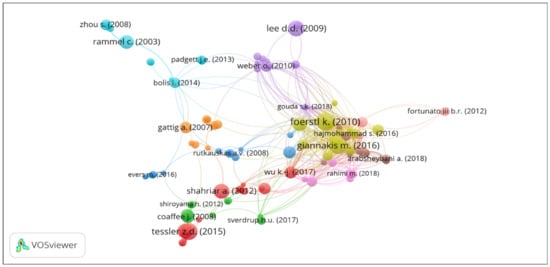
Figure 7.
Citations of document network using VOSviewer.
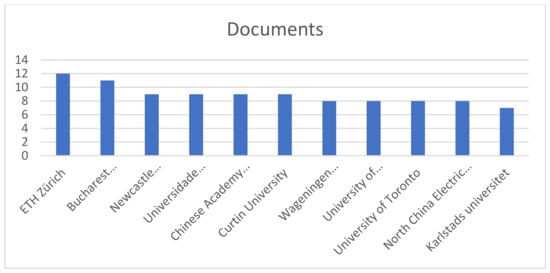
Figure 8.
Affiliations of universities by documents published.
The research output in sustainability has grown sharply compared to the findings of similar bibliometric studies [11,12,14]; more countries, affiliations, and authors engaged in sustainability research outputs, and the sustainability topic has more connections with several new disciplines and fields. The study of [11], regarding the energy being linked with public participation, has resulted in 12,000 publications. The publications focus on the topic of sustainability, sustainable energy, energy efficiency, and sustainable environment.
4. Discussion on Cluster Analysis
Cluster analysis, content analysis, and future research questions are presented in Table 5. To create a cluster, we constructed mainly five columns. The most significant purpose of analyzing the cluster was to evaluate the vital top journals and articles we cited based on the context of sustainability and risk management actionable measures. We created a table mainly with five leads streams: authors of the streams, the purpose of the vital paper, the main findings, and lastly, we framed recommendations, which we transformed into main research questions. We searched the key journals related to sustainability and risk management to generate the streams of information from Scopus. Then, we cited the journals’ prominent authors who contributed their efforts to the context, mentioning the published years of the articles released. To track the keywords, we gathered some samples for clustering the streams that included keywords, such as life cycle, risk assessment, risk perception, sustainability development, environmental protection, risk factors, climate change, and disaster management. From the main leads of keywords, we framed six streams relating to the subject. We framed lead questions for six selected streams, plotting two primary citations of top authors and 24 research questions.

Table 5.
Cluster analysis, content analysis, and future research questions.
Outcomes in the Stream
Mainly, we accumulated six key streams from Scopus on the related topics of sustainability and risk assessment. The primary purpose of using streams was to specify the crucial papers in related literature. Moral responsibility and sustainability development were a significant stream that we selected. The author [3] highlights the importance of sustainability practices, considering it to be an ethical responsibility for employees to engage in community development. The primary outcome is that it teaches us to contribute individual support, apart from businesses solely being responsible for sustainability. In the second stream, “blockchain technology minimizing risk”, we selected this stream to recognize how crucial innovative technology advancements, such as blockchain, can reduce errors and provide security, preventing consequential losses. The third stream, “social sustainability and supply chain management”, from the author [61], related how sustainability practices in a supply chain sector can be influenced using tools of meta-analysis. The fourth stream, “environmental impact”, was also an essential keyword that we selected from Scopus; it relates to sustainability practices. The author stresses the importance of environmentally friendly ecosystems, encouraging the use of green initiatives. The fifth stream was safety engineering; we selected this relevant topic, which is closer to mitigating risks. The stream cited significant highlights on influencing other sectors to undertake safety measures that could help minimize risks from unknown situations. The last stream was optimization, which related to measures every member of a society could manage within the existing resources, such as not wasting water and not polluting the environment.
5. Recommendation for Future Research
We learned how to find keywords with content analysis using the comprehensive research study’s bibliometric software. VOSviewer tool was a great tool where we learned how to export information from Scopus to excel and workbook. We learned how to construct bibliometric figures derived from top-cited journals, authors, and citations from top publications with various functions such as coupling, co-authorships, and bibliographic co-citations. First, we went through top quoted journals on sustainability and risk that showed significant citations. In the second stage, we collected the top 10 influential articles where we put the keywords and found the analysis of citations, country origin, citations of journals, documents, affiliations, and leading universities’ sources. In the third stage, we picked up only relevant samples of journals related to the study. Fourth, we created a context on cluster analysis where we analyzed streams, authors, the purpose of the articles, and main findings on the streams’ themes. We converted the research agenda to research questions. In the table of the cluster, we converted 24 future research question into an agenda for future recommendations. We have suggested a requirement for future academics to study the subject of sustainability practices as we found that the research related to sustainability and risks in an economy were cited with limited analysis. We also would recommend that the academicians structure an improved version of the research agendas that can help management understand the real importance of sustainability and risk assessments in an economy. Unsustainability practices are a challenge that can strike in an economy if not managed resourcefully. In the future, if no practical actions and exceptions of effective strategies are on the horizon, and the assessment of risks also remains a more significant challenge, risks become static rather than speculative.
6. Conclusions
Sustainability is an issue from a global perspective that remains a challenge for corporate, business, or individual points of view. At the same time, the factors of risks remain unavoidable in any circumstances of an economy. It is our social responsibility to make wiser and objective concerns for welfare. We exist to prevent the depletion of natural resources, secure waste management, prevent pollution, and cooperate with the nation’s compliance. Automatically, economic development flow can be improved if we consider taking wiser steps in preventing the economy from degradation. In our recommendations, we also developed specific, actionable measures on how sustainability leads to positive contributions. This bibliometric report is an effort to summarize the collected works on sustainability and assessment of risks in general. The countries, journals, sources, and organizations were assessed. The results were presented through tables and figures. Each figure represents the nodes and lines of the analysis. Nodes represent the journals, publications, authors, and countries; on the other hand, lines show the collaborative relations among the nodes. We also created a co-citation reference network in sustainability and risk management, which resulted in six clusters, such as the moral responsibilities and sustainability development, blockchain technology and minimization of risks, social sustainability and supply chain, environmental impacts, safety engineering and risk identification, and optimization and sustainability practices.
Our bibliometric analysis limitation was the gaps in conceptions where the top authors did not reference all the most essential citations. It implied that essential citations by the top authors who wrote the articles missed out. In addition to that, we used the Scopus database to obtain different articles and journals, which we evaluated through bibliometrics. There are several important articles that we missed that are available from other databases and that we did not obtain from the Scopus database. In the future, we recommend that the influential authors who publish their journal documents need to include the well-known and most essential references from top journals from the top-cited papers. As for the database, we recommend that future researchers consider other databases to ensure that the important journals will be covered in the future study
Author Contributions
H.N. developed the research idea and research design, helped in data collection and analysis generated from VOSviewer and Scopus, prepared the tables and figures, reviewed the work, and led the project team; F.Y.A.H. formed and designed this research; L.S.A. also contributed to research idea. A.F.A. performed the research and analyzed the data; H.N. contributed analysis tools and editing. F.Y.A.H., F.A.A. and H.A.A. wrote the paper. S.K.A.; S.M.A. helped build the idea further and offered critical editing support. All authors have read and agreed to the published version of the manuscript.
Funding
This research received no external funding.
Institutional Review Board Statement
Not applicable.
Informed Consent Statement
Not applicable.
Data Availability Statement
Data sharing is not applicable to this article.
Acknowledgments
All the thanks and appreciation from our team to the editor and reviewers.
Conflicts of Interest
The authors declare no conflict of interest.
References
- Purvis, B.; Mao, Y.; Robinson, D. Three pillars of sustainability: In search of conceptual origins. Sustain. Sci. 2019, 14, 681–695. [Google Scholar] [CrossRef]
- Powers, M.R. Pure vs Speculative Risk: False Choice; Sham Marriage. J. Risk Financ. 2006, 7, 345–347. [Google Scholar] [CrossRef]
- Sadollah, A.; Nasir, M.; Geem, Z.W. Sustainability and Optimization: From Conceptual Fundamentals to Applications. Sustain. J. Rec. 2020, 12, 2027. [Google Scholar] [CrossRef]
- Manab, N.A.; Aziz, N.A.A. Integrating knowledge management in sustainability risk management practices for company survival. Manag. Sci. Lett. 2019, 9, 585–594. [Google Scholar] [CrossRef]
- Zhu, J.; Hua, W. Visualizing the knowledge domain of sustainable development research between 1987 and 2015: A bibliometric analysis. Scientometrics 2017, 110, 893–914. [Google Scholar] [CrossRef]
- Maier, D.; Maier, A.; Așchilean, I.; Anastasiu, L.; Gavriș, O. The Relationship between Innovation and Sustainability: A Bibliometric Review of the Literature. Sustainability 2020, 12, 4083. [Google Scholar] [CrossRef]
- Bessant, J.; Tidd, J. Innovation and Entrepreneurship; John Wiley & Sons: Hoboken, NJ, USA, 2007. [Google Scholar]
- Jurisch, M.C.; Rosenberg, Z.; Krcmar, H. Emergent risks in business process change projects. Bus. Process. Manag. J. 2016, 22, 791–811. [Google Scholar] [CrossRef]
- Martinez, M.G.; Zouaghi, F.; Marco, T.G.; Robinson, C. What drives business failure? Exploring the role of internal and external knowledge capabilities during the global financial crisis. J. Bus. Res. 2019, 98, 441–449. [Google Scholar] [CrossRef]
- Galaz, V.; Gars, J.; Moberg, F.; Nykvist, B.; Repinski, C. Why Ecologists Should Care about Financial Markets. Trends Ecol. Evol. 2015, 30, 571–580. [Google Scholar] [CrossRef] [PubMed]
- Garrigos-Simon, F.J.; Botella-Carrubi, M.D.; Gonzalez-Cruz, T.F. Social Capital, Human Capital, and Sustainability: A Bibliometric and Visualization Analysis. Sustain. J. Rec. 2018, 10, 4751. [Google Scholar] [CrossRef]
- González-Torres, T.; Rodríguez-Sánchez, J.-L.; Pelechano-Barahona, E.; García-Muiña, F.E. A Systematic Review of Research on Sustainability in Mergers and Acquisitions. Sustain. J. Rec. 2020, 12, 513. [Google Scholar] [CrossRef]
- Tang, M.; Liao, H.; Wan, Z.; Herrera-Viedma, E.; Rosen, M.A. Ten Years of Sustainability (2009–2018): A Bibliometric Overview. Sustain. J. Rec. 2018, 10, 1655. [Google Scholar] [CrossRef]
- Hallinger, P.; Nguyen, V.-T. Mapping the Landscape and Structure of Research on Education for Sustainable Development: A Bibliometric Review. Sustain. J. Rec. 2020, 12, 1947. [Google Scholar] [CrossRef]
- Nielsen, L.; Faber, M.H. Data Report for the Bibliometric Analysis of Risk, Sustainability and Resilience Research from 1990–2017; Technical report No. 248; Aalborg University: Aalborg, Denmark, 2018. [Google Scholar]
- Herrera-Franco, G.; Montalván-Burbano, N.; Carrión-Mero, P.; Apolo-Masache, B.; Jaya-Montalvo, M. Research Trends in Geotourism: A Bibliometric Analysis using the Scopus Database. Geosciences 2020, 10, 379. [Google Scholar] [CrossRef]
- Van Eck, N.J.; Waltman, L. Citation-based clustering of publications using CitNetExplorer and VOSviewer. Scientometrics 2017, 111, 1053–1070. [Google Scholar] [CrossRef] [PubMed]
- Muñoz, P.; Janssen, F.; Nicolopoulou, K.; Hockerts, K. Advancing sustainable entrepreneurship through substantive research. Int. J. Entrep. Behav. Res. 2018, 24, 322–332. [Google Scholar] [CrossRef]
- Corsini, F.; Certomà, C.; Dyer, M.; Frey, M. Participatory energy: Research, imaginaries and practices on people contribute to energy systems in the smart city. Technol. Forecast. Soc. Chang. 2019, 142, 322–332. [Google Scholar] [CrossRef]
- Župič, I.; Čater, T. Bibliometric Methods in Management and Organization: A Review. SSRN Electron. J. 2013, 18, 429–472. [Google Scholar] [CrossRef]
- Liao, H.; Tang, M.; Luo, L.; Li, C.; Chiclana, F.; Zeng, X.-J. A Bibliometric Analysis and Visualization of Medical Big Data Research. Sustainability 2018, 10, 166. [Google Scholar] [CrossRef]
- Van Eck, N.J.; Waltman, L. Software survey: VOSviewer, a computer program for bibliometric mapping. Scientometrics 2010, 84, 523–538. [Google Scholar] [CrossRef]
- Kaur, J.; Radicchi, F.; Menczer, F. Universality of scholarly impact metrics. J. Inf. 2013, 7, 924–932. [Google Scholar] [CrossRef]
- Grandjean, P.; Eriksen, M.L.; Ellegaard, O.A.; Wallin, J. The Matthew effect in environmental science publication: A bibliometric analysis of chemical substances in journal articles. Environ. Health 2011, 10, 96. [Google Scholar] [CrossRef] [PubMed]
- Pizzi, S.; Caputo, A.; Corvino, A.; Venturelli, A. Management research and the UN sustainable development goals (SDGs): A bibliometric investigation and systematic review. J. Clean. Prod. 2020, 276, 124033. [Google Scholar] [CrossRef]
- Zhang, Y.; Huang, K.; Yu, Y.; Yang, B. Mapping of water footprint research: A bibliometric analysis during 2006–2015. J. Clean. Prod. 2017, 149, 70–79. [Google Scholar] [CrossRef]
- Jalal, S. Co-Authorship and Co-Occurrences Analysis using Bibliometrixr Package: A Case Study of India and Bangladesh. Ann. Libr. Inf. Stud. 2019, 66, 57–64. [Google Scholar]
- Small, H. Co-citation in the scientific literature: A new measure of the relationship between two documents. J. Am. Soc. Inf. Sci. 1973, 24, 265–269. [Google Scholar] [CrossRef]
- Giraldo, P.; Benavente, E.; Manzano-Agugliaro, F.; Gimenez, E. Worldwide Research Trends on Wheat and Barley: A Bibliometric Comparative Analysis. Agronomy 2019, 9, 352. [Google Scholar] [CrossRef]
- Dong, Y.; Frangopol, D.M. Risk and resilience assessment of bridges under mainshock and aftershocks incorporating uncertainties. Eng. Struct. 2015, 83, 198–208. [Google Scholar] [CrossRef]
- Li, Y.P.; Nie, S.; Huang, C.Z.; McBean, E.A.; Fan, Y.R.; Huang, G.H. An Integrated Risk Analysis Method for Planning Water Resource Systems to Support Sustainable Development of an Arid Region. J. Environ. Inf. 2017, 29, 1–15. [Google Scholar] [CrossRef]
- Mangla, S.K.; Kumar, P.; Barua, M.K. Flexible Decision Approach for Analysing Performance of Sustainable Supply Chains under Risks/Uncertainty. Glob. J. Flex. Syst. Manag. 2014, 15, 113–130. [Google Scholar] [CrossRef]
- Caparros-Midwood, D.; Dawson, R.; Barr, S. Optimization of urban spatial development against flooding and other climate risks, and wider sustainability objectives. In Proceedings of the 3rd European Conference on Flood Risk Management (FLOODrisk 2016), Newcastle upon Tyne, UK, 20 October 2016. [Google Scholar] [CrossRef]
- Busse, C.; Kach, A.P.; Bode, C. Sustainability and the False Sense of Legitimacy: How Institutional Distance Augments Risk in Global Supply Chains. J. Bus. Logist. 2016, 37, 312–328. [Google Scholar] [CrossRef]
- Caparros-Midwood, D.; Dawson, R.; Barr, S. Low Carbon, Low Risk, Low Density: Resolving choices about sustainable development in cities. Cities 2019, 89, 252–267. [Google Scholar] [CrossRef]
- Dawson, R. Re-engineering cities: A framework for adaptation to global change. Philos. Trans. R. Soc. A Math. Phys. Eng. Sci. 2007, 365, 3085–3098. [Google Scholar] [CrossRef]
- Rahimi, M.; Ghezavati, V. Sustainable multi-period reverse logistics network design and planning under uncertainty utilizing conditional value at risk (CVaR) for recycling construction and demolition waste. J. Clean. Prod. 2018, 172, 1567–1581. [Google Scholar] [CrossRef]
- Hedelin, B. The Sustainable Procedure Framework for Disaster Risk Management: Illustrated by the Case of the EU Floods Directive in Sweden. Int. J. Disaster Risk Sci. 2016, 7, 151–162. [Google Scholar] [CrossRef]
- Canzaniello, A.; Hartmann, E.; Fifka, M.S. Intra-industry strategic alliances for managing sustainability-related supplier risks. Int. J. Phys. Distrib. Logist. Manag. 2017, 47, 387–409. [Google Scholar] [CrossRef]
- Hofmann, H.; Busse, C.; Bode, C.; Henke, M. Sustainability-Related Supply Chain Risks: Conceptualization and Management. Bus. Strat. Environ. 2014, 23, 160–172. [Google Scholar] [CrossRef]
- Jiang, P.; Fu, X.; Van Fan, Y.; Klemeš, J.J.; Chen, P.; Ma, S.; Zhang, W. Spatial-temporal potential exposure risk analytics and urban sustainability impacts related to COVID-19 mitigation: A perspective from car mobility behaviour. J. Clean. Prod. 2021, 279, 123673. [Google Scholar] [CrossRef] [PubMed]
- Lattimore, B.; Smith, C.T.; Titus, B.; Stupak, I.; Egnell, G. Woodfuel Harvesting: A Review of Environmental Risks, Criteria and Indicators, and Certification Standards for Environmental Sustainability. J. Sustain. For. 2013, 32, 58–88. [Google Scholar] [CrossRef]
- Lattimore, B.; Smith, C.; Titus, B.; Stupak, I.; Egnell, G. Environmental factors in woodfuel production: Opportunities, risks, and criteria and indicators for sustainable practices. Biomass Bioenergy 2009, 33, 1321–1342. [Google Scholar] [CrossRef]
- Kittler, B.; Stupak, I.; Smith, C.T. Assessing the wood sourcing practices of the U.S. industrial wood pellet industry supplying European energy demand. Energy Sustain. Soc. 2020, 10, 1–17. [Google Scholar] [CrossRef]
- Choi, T.-M.; Chiu, C.-H. Mean-downside-risk and mean-variance newsvendor models: Implications for sustainable fashion retailing. Int. J. Prod. Econ. 2012, 135, 552–560. [Google Scholar] [CrossRef]
- Wu, K.-J.; Liao, C.-J.; Tseng, M.-L.; Lim, M.K.; Hu, J.; Tan, K. Toward sustainability: Using big data to explore the decisive attributes of supply chain risks and uncertainties. J. Clean. Prod. 2017, 142, 663–676. [Google Scholar] [CrossRef]
- Beaver, D.D. Reflections on Scientific Collaboration (and its study): Past, Present, and Future. Scientometrics 2001, 52, 365–377. [Google Scholar] [CrossRef]
- Griffith, B.C.; Small, H.G.; Stonehill, J.A.; Dey, S. The Structure of Scientific Literatures II: Toward a Macro- and Microstructure for Science. Sci. Stud. 1974, 4, 339–365. [Google Scholar] [CrossRef]
- Mahapatra, G. Bibliometric Studies on Indian library and Information Science Literature; Crest Publishing House: New Delhi, India, 2000. [Google Scholar]
- Sendlhofer, T. Decoupling from Moral Responsibility for CSR: Employee’s Visionary Procrastination at a SME. J. Bus. Ethic. 2020, 167, 361–378. [Google Scholar] [CrossRef]
- Nicholson, J.; Kurucz, E. Relational Leadership for Sustainability: Building an Ethical Framework from the Moral Theory of ‘Ethics of Care’. J. Bus. Ethic. 2019, 156, 25–43. [Google Scholar] [CrossRef]
- Abdel-Basset, M.; Gunasekaran, M.; Mohamed, M.; Chilamkurti, N. Retracted: A framework for risk assessment, management and evaluation: Economic tool for quantifying risks in supply chain. Futur. Gener. Comput. Syst. 2019, 90, 489–502. [Google Scholar] [CrossRef]
- Rana, R.; Zaeem, R.N.; Barber, K.S. An Assessment of Blockchain Identity Solutions: Minimizing Risk and Liability of Authentication. In Proceedings of the IEEE/WIC/ACM International Conference on Web Intelligence; Association for Computing Machinery (ACM), Thessaloniki, Greece, 14–17 October 2019; pp. 26–33. [Google Scholar]
- D’Eusanio, M.; Zamagni, A.; Petti, L. Social sustainability and supply chain management: Methods and tools. J. Clean. Prod. 2019, 235, 178–189. [Google Scholar] [CrossRef]
- Orji, I.J.; Kusi-Sarpong, S.; Gupta, H. The critical success factors of using social media for supply chain social sustainability in the freight logistics industry. Int. J. Prod. Res. 2020, 58, 1522–1539. [Google Scholar] [CrossRef]
- Elsaid, K.; Kamil, M.; Sayed, E.T.; Abdelkareem, M.A.; Wilberforce, T.; Olabi, A. Environmental impact of desalination technologies: A review. Sci. Total. Environ. 2020, 748, 141528. [Google Scholar] [CrossRef] [PubMed]
- Taşkın, A.; Demir, N. Life cycle environmental and energy impact assessment of sustainable urban municipal solid waste collection and transportation strategies. Sustain. Cities Soc. 2020, 61, 102339. [Google Scholar] [CrossRef]
- Amin, T.; Khan, F.; Amyotte, P. A bibliometric review of process safety and risk analysis. Process. Saf. Environ. Prot. 2019, 126, 366–381. [Google Scholar] [CrossRef]
- Van Coile, R.; Hopkin, D.; Lange, D.; Jomaas, G.; Bisby, L. The Need for Hierarchies of Acceptance Criteria for Probabilistic Risk Assessments in Fire Engineering. Fire Technol. 2019, 55, 1111–1146. [Google Scholar] [CrossRef]
- Wu, Y.; Xu, C.; Ke, Y.; Tao, Y.; Li, X. Portfolio optimization of renewable energy projects under type-2 fuzzy environment with sustainability perspective. Comput. Ind. Eng. 2019, 133, 69–82. [Google Scholar] [CrossRef]
- Chen, X.; Chen, J.; Wu, D.; Xie, Y.; Li, J. Mapping the Research Trends by Co-word Analysis based on Keywords from Funded Project. Proc. Comput. Sci. 2016, 91, 547–555. [Google Scholar] [CrossRef]
Publisher’s Note: MDPI stays neutral with regard to jurisdictional claims in published maps and institutional affiliations. |
© 2021 by the authors. Licensee MDPI, Basel, Switzerland. This article is an open access article distributed under the terms and conditions of the Creative Commons Attribution (CC BY) license (http://creativecommons.org/licenses/by/4.0/).